The first (ΔIH1) and second (ΔIH2) ionisation enthalpies (in kJ mol−1) and the (ΔegH) electron gain enthalpy (in kJ mol−1) of a few elements are given below:

The least reactive element is :
P
Q
R
T
The correct Answer is:D
Value corresponds to noble gases.Hence , T is inert toward chemical reactivity.
Topper's Solved these Questions
Similar Questions
The first (Δi,H1) and the second (Δ,H2) ionisation enthalpies (in kJ mol−1 ) and the (ΔegH) electron gain enthalpy (in kJ mol−1 ) of a few elements are given below :
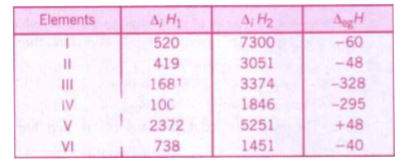
Which of the above elements is likely to be :
the least reactive element?
View SolutionThe first (Δi,H1) and the second (Δ,H2) ionisation enthalpies (in kJ mol−1 ) and the (ΔegH) electron gain enthalpy (in kJ mol−1 ) of a few elements are given below :
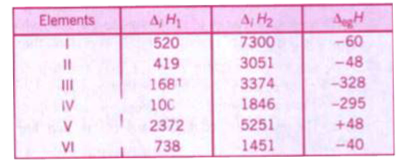
Which of the above elements is likely to be :
a reactive metal
View Solution
Knowledge Check
The first (ΔiH1) and second (ΔiH2) ionization enthalpies (in kJ mol−1) and the electron gain enthalpy (ΔegH)(in kJ mol−1) of the elements I, II, III, IV and V are given below
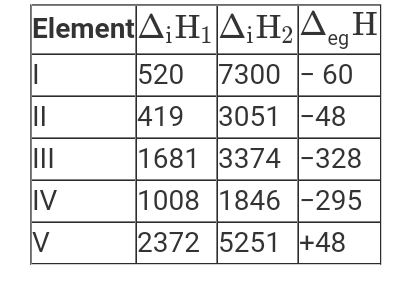
the least reactive non - metal and the most reactive metal of these are respectivelyAIV and VBII and VCV and IIIDV and IIThe first (ΔiH1 and second (ΔiH2 ionization enthalpies (in kJ/mol) and electron gain enthalpy (in kJ/mol) of few elements are given below:
ElementsΔiH1ΔiH2ΔegHI5207300−60II16813374−328III8991757+48IV23725251+48
Which of the above is likely to be He:AIBIICIIIDIVThe first (ΔiH1 and second (ΔiH2 ionization enthalpies (in kJ/mol) and electron gain enthalpy (in kJ/mol) of few elements are given below:
ElementsΔiH1ΔiH2ΔegHI5207300−60II16813374−328III8991757+48IV23725251+48
Which of the following is likely to be an alkali metal?AIBIICIIIDIV
The first (ΔH1) and second (ΔH2) ionisation enthalpies (in kJmol−1) and the (ΔHeg) electron gain enthalpy (in kJmol−1) of a elements are given below:
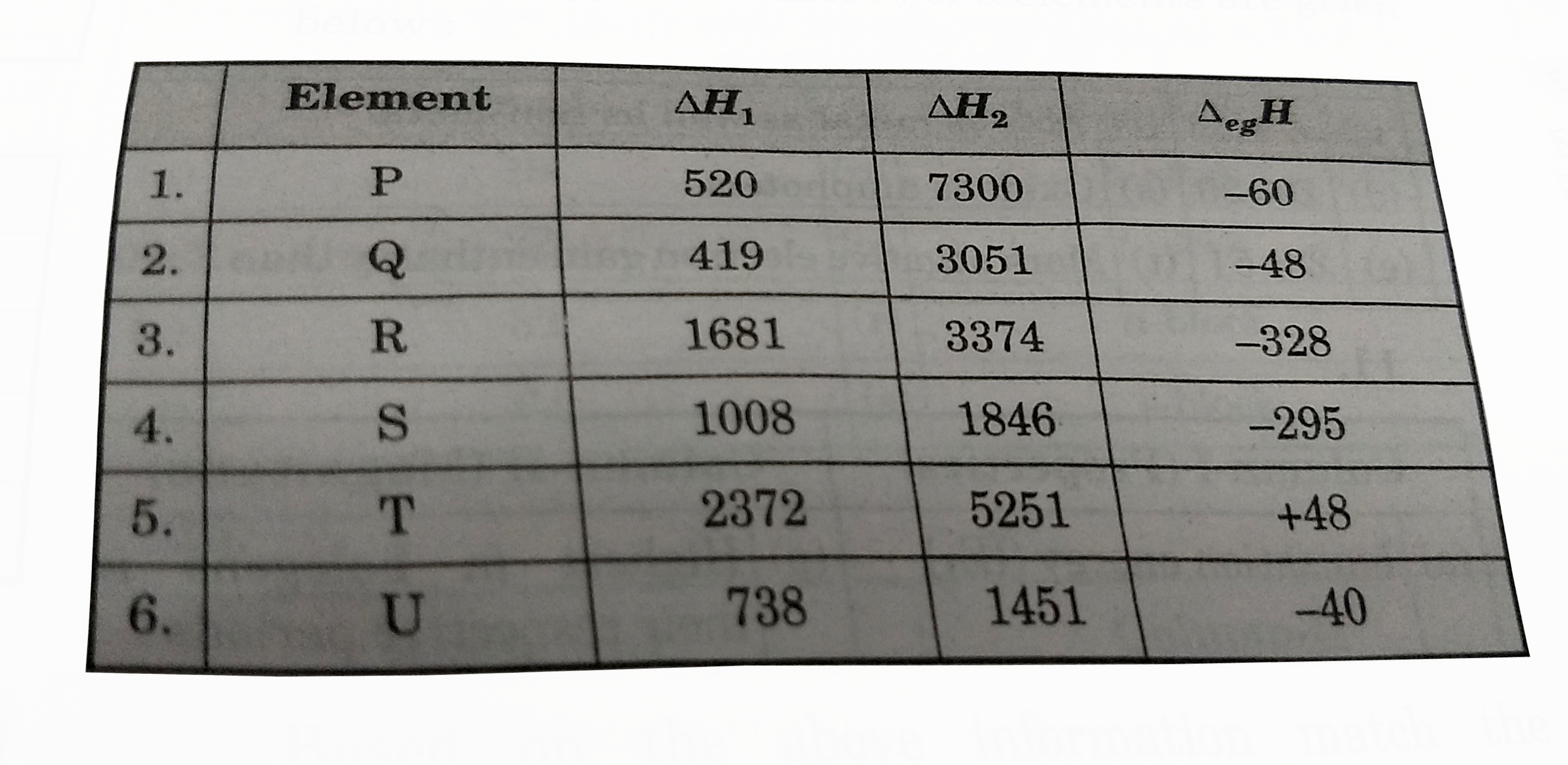
Based on the above information match the following columns.
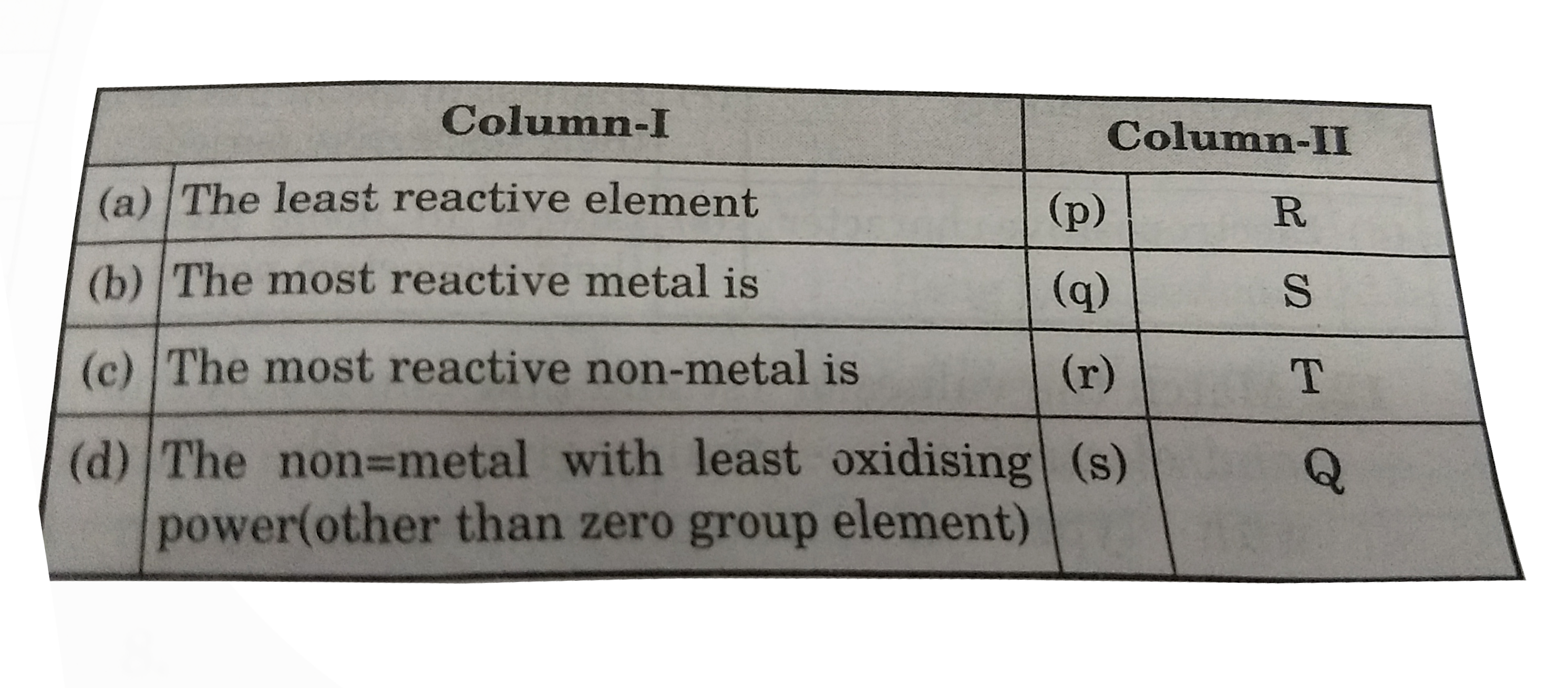
View SolutionThe first (ΔH1) and second (ΔH2) ionisation enthalpies (in kJmol−1) and the (ΔHeg) electron gain enthalpy (in kJmol−1) of a elements are given below:

Based on the above information match the following columns.

View SolutionThe first (ΔiH1) and second (ΔiH2) ionisation enthalpies (inkJmol−1) and the (ΔegHө) electron gain enthalpy (inkJmol−1) of a few elements are given below:
Elements(ΔiH1)(ΔiH2)ΔegHөI5207300−60II4193051−48III16813374−328IV10081846−295V23725251+48VI7381451−40
Which of the above elements is likely to be
a. the least reactive element.
b. the most reactive metal.
c. the most reactive non-metal.
d. the least reactive non-metal.
e. the metal which can form a stable binary halide of the formula MX2 (X=halogen).
f. the metal which can form a predominantly stable covalent halide of the formula MX(X=halogen).
View SolutionThe first (ΔiH1) and second (ΔiH2) ionisation enthalpies (inkJmol−1) and the (ΔegHө) electron gain enthalpy (inkJmol−1) of a few elements are given below:
Elements(ΔiH1)(ΔiH2)ΔegHөI5207300−60II4193051−48III16813374−328IV10081846−295V23725251+48VI7381451−40
Which of the above elements is likely to be
a. the least reactive element.
b. the most reactive metal.
c. the most reactive non-metal.
d. the least reactive non-metal.
e. the metal which can form a stable binary halide of the formula MX (X=halogen).
f. the metal which can form a predominantly stable covalent halide of the formula MX(X=halogen).
View SolutionThe first (ΔiH1) and second (ΔiH2) ionisation enthalpies (inkJmol−1) and the (ΔegHө) electron gain enthalpy (inkJmol−1) of a few elements are given below:
Elements(ΔiH1)(ΔiH2)ΔegHөI5207300−60II4193051−48III16813374−328IV10081846−295V23725251+48VI7381451−40
Which of the above elements is likely to be
a. the least reactive element.
b. the most reactive metal.
c. the most reactive non-metal.
d. the least reactive non-metal.
e. the metal which can form a stable binary halide of the formula MX2 (X=halogen).
f. the metal which can form a predominantly stable covalent halide of the formula MX(X=halogen).
View Solution
